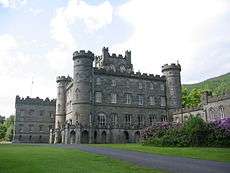Taymouth Castle

Taymouth Castle is situated just north-east of the village of Kenmore, Perth and Kinross in the Highlands of Scotland. It stands on the site of the much older Balloch Castle (built in 1550), which was demolished to be rebuilt on a much larger scale in the early 19th century by the Campbells of Breadalbane.
Built in the neo-Gothic style on a lavish scale, no expense was spared on the castle's interior, which was decorated with extravagant sumptuousness incorporating carvings, plasterwork and murals. Panels of medieval stained glass and Renaissance woodwork were incorporated into the scheme. Much of this decor survives, though the castle has lost most of its original rich furnishings. It has been empty since 1979, although plans have been put forward for its redevelopment as a luxury hotel.
The castle is a category A listed building,[1] and the grounds are included in the Inventory of Gardens and Designed Landscapes, the national listing of significant gardens.[2]
History
Balloch Castle
A tower house on the site, known as Balloch Castle, was built around 1550 by Sir Colin Campbell of Glenorchy,[3] descendent of Duncan Campbell, 1st Lord Campbell. Sir Colin's son, Sir Duncan Campbell, was made a baronet in 1625. James VI visited the castle in August 1582, tipping the gardener 40 shillings - only a few days later he was seized at the Ruthven Raid.[4]
18th-century rebuilding

Sir Duncan Campbell's descendent John Campbell was created Earl of Breadalbane and Holland in 1681. In 1720 the 2nd Earl commissioned William Adam to remodel the house and lay out extensive formal gardens.[5] The 2nd Earl's son oversaw further changes in the 1750s, and by the 1780s the formal gardens had been replaced with a picturesque landscape in the manner of Stourhead and Painshill Park.[5]
The present castle
The 4th Earl called upon Robert Mylne to prepare plans for a new "chateau" in 1789, though they were not carried out.[5] Ten years later the main block of the old house was demolished, to be replaced from 1806 by a Gothic building to the designs of the brothers James and Archibald Elliot. The English-Italian Francis Bernasconi carried out the ornate plasterwork of the staircase and drawing rooms between 1809 and 1812.[1] In 1818 the old east wing was pulled down and replaced by a two-storey wing designed by William Atkinson.[1]
The 4th Earl, created Marquess of Breadalbane in 1831, was succeeded by the 2nd Marquess in 1834. He completed the improvements from 1838, by the remodelling of William Adam's west wing, which was enlarged and refaced to match the main block. This time the architect was James Gillespie Graham, with interiors designed by A. W. N. Pugin. The ceilings of the west wing are described by Historic Scotland as the "finest of their period in UK".[1] The works were complete by 1842, in time for the first visit to Scotland of Queen Victoria and Prince Albert, when they stayed at Taymouth for three days.[5]
On the death of the 2nd Marquess, Taymouth passed to a distant cousin, along with the Earldom of Breadalbane. The Marquessate was re-created for his son Gavin Campbell in 1885. The family estates were much reduced during his tenure, and on his death in 1922 Taymouth Castle was sold.[5] It was converted into a hotel, opening in 1929, with an 18-hole golf course designed by James Braid in the grounds. It was used as a hospital for Polish troops during the Second World War, and between 1950 and 1968 it housed the Civil Defence Corps training school for Scotland.[6] Taymouth was subsequently used by a boarding school for American children. This closed in 1979 and the building was empty, although the golf course has continued to be operated separately.[5]
Restoration
In 2004, it was reported that plans to redevelop the castle as a "six-star" hotel had been approved by Perth and Kinross Council.[7] By May 2006 the main buildings were stabilised,[8] with further restoration continuing in the following years including new windows, extensive refurbishment to the state rooms and a new roof. In 2015 work began on creating luxury hotel suites under the banner of Taymouth Castle Estate. The luxury hotel is due to open in mid-2016. Today the Castle is open as an events venue for weddings and special events.
References
- 1 2 3 4 "Taymouth Castle". Historic Scotland. Retrieved 11 January 2013.
- ↑ "Taymouth Castle". An Inventory of Gardens and Designed Landscapes in Scotland. Historic Scotland. Retrieved 11 January 2013.
- ↑ "Taymouth Castle". RCAHMS. Retrieved 11 January 2013.
- ↑ National Archives of Scotland E22/5 August 1582
- 1 2 3 4 5 6 "Taymouth Castle: Site History". An Inventory of Gardens and Designed Landscapes in Scotland. Historic Scotland. Retrieved 11 January 2013.
- ↑ Alley, Eric (2005). Essex-Lopresti, Tim, ed. "Civil Defence Corps 1949 - 1968" (PDF). A Brief history of Civil Defence. Civil Defence Association. pp. 35,55.
- ↑ "Council backs castle hotel plans". BBC News. 4 August 2004.
- ↑ "Castle resort work ahead of plan". BBC News. 19 May 2006.
External links
| Wikimedia Commons has media related to Taymouth Castle. |
- Taymouth Castle Estate
- Taymouth Castle, Breadalbane community website
Coordinates: 56°35′42″N 3°58′52″W / 56.59500°N 3.98111°W